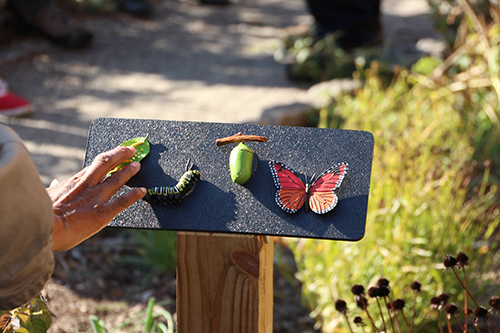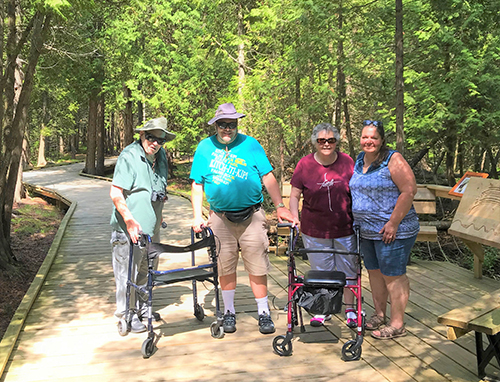As the threat of the climate crisis becomes ever more imminent, the importance and benefits of nature to human health become ever more undeniable. Highlighted in books such as “Forest Bathing: How Trees Can Help You Find Health and Happiness” by Qing Li, various practices of nature therapy are said to improve mental and physical health. A 2018 report from the Nature Conservancy states “a growing body of scientific evidence suggests contact with nature provides a multitude of health benefits...nearby nature provides a positive emotional experience that has been shown to speed up recovery time for hospitalized patients, motivate healthy behaviors such as exercise, and provide therapeutic benefits to people living with mental disorders.”
Due to the varied and often challenging terrain the natural environment can present (steep grades, unpaved pathways and delicate ecosystems), access to our natural resources for those with physical disabilities has historically been confined to the parking lots and nature centers, restricting their ability to fully partake in the benefits of a natural connection.
Nature conservancies, sanctuaries and parks stand at the crossroads of protecting the natural environment and educating the public. From local conservancies to the National Parks Service, environmental organizations are creating inclusive opportunities for the public to enjoy our resources responsibly.
Mass Audubon in Massachusetts and the Ridges Sanctuary in Michigan are two such organizations striving to create accessible and inclusive nature experiences, while educating visitors about the ecosystems they inhabit. Like many environmental organizations, the primary tenet of both missions is to protect the nature of their region, with values emphasizing stewardship, education and community to support those missions. Mass Audubon states “we care deeply about our colleagues, our partners, our members, and the communities in which we work. We learn from their experience, expertise, and beliefs, and we embrace diversity to build conservation communities that welcome and respect all people.”

All Persons Trails
This eye for inclusion has led to the development of Americans with Disabilities Act (ADA) and accessible-for-all boardwalks and pathways at both organizations. Mass Audubon, which has been making their wildlife sanctuaries ADA-compliant for over 20 years, received a grant from the Institute of Museum and Library Services (IMLS) in 2010 to create “sensory trails.” This led to the development and installation of 12 All Persons Trails at Mass Audubon sanctuaries across Massachusetts. “To name one of our trails an All Persons Trail, it has to meet ADA compliance. We have to check off all of those boxes ,” explains the Statewide Education Projects Manager, Lucy Gertz.
All Persons Trails go far beyond ADA compliance however. “There are navigational cues,” Mass Audubon’s Gertz continues, “All visitors should be able to navigate these trails independently if they choose.” The navigational cues include rope guides with beads to indicate audio stops or seatings based on shape, tour materials accessible through printed materials (large print or braille) or audio (via cell phone or on a Mass Audubon device). “Everything that’s available in the printed materials matches everything that’s available on audio, and these materials are available on arrival or ahead of time,” says Gertz.
Another popular feature of the All Persons Trails are the tactile displays. In addition to a tactile map, many of the stops include life-size tactile models of birds, frogs, turtles, insects and other creatures found in the sanctuaries.

The Ridges at Bailey’s Harbor
At the Ridges Sanctuary, the opening of a new nature center in 2015 provided the perfect opportunity to increase access with the Hidden Brook Boardwalk. “We’re extremely dedicated to our mission,” shares Katie Krouse, Program Manager at the Ridges, “to protect and preserve the Ridges and Swales throughout Baileys Harbor, to educate people on their importance and connect with the community through public outreach.”
Located at the nature center and completed in 2016, the one-third mile boardwalk is ADA accessible and allows visitors with mobility impairments access to the ridges and swales they learn about it in the nature center itself. “It totally changed the face of the ridges, the nature center is nothing without the boardwalk,” Krouse remarks. “We didn’t stop there, of course. We want to make sure we’re moving towards complete accessibility.”

In addition to joining the staff, volunteers and board members that spearheaded the Boardwalk, Krouse worked alongside a community member to introduce hearing loops throughout the center, including outdoors so that hike leaders and naturalists can communicate to those with hearing impairments.
“We’re still in the process, we’re still learning,” says Krouse while discussing services for visitors with vision impairments. Along with large print maps, the boardwalk and nature center feature tactile experiences, but the sanctuary is working towards a braille map and the opportunity for self-guided walks.
Navigating Nature
Unlike the built and controlled environment of many cultural institutions, when planning for visitor traffic, nature preserves and sanctuaries must consider the natural ecological habitats above all else. “We manage more than 38,000 acres of habitat,” states Gertz, “my science colleagues are very good at knowing where there should and shouldn’t be visitors.”
In the case of the Boardwalk at the Ridges, the ability to create an accessible trail actually allows the land more space. “Getting people up and off the ground [on the lifted Boardwalk] is giving it the land a chance. It gave us an opportunity to use this part of our property as a living laboratory and allow the property to restore itself” says Krouse.
A Community Effort
Both Gertz and Krouse are adamant about the importance of involving the community in the creation of these services. From donors and board members to volunteers and family, community members are a valuable resource and partner.
“Each trail has 7-10 local community members who I work with to develop, test and refine the trail services,” says Gertz of the community effort. “It’s a very inclusive process. We were advised early on not to build an accessible trail without having potential trail users test it during development, and now wouldn’t do it any other way.”
“We have these amazing volunteers who are passionate about this as well, making these connections in the community, telling people that we have this. We have this incredible support system that allows it to be an incredible system,” shares Krouse of the ongoing efforts.
“The most important thing is to not do this alone,” adds Gertz.
Images courtesy of Mass Audubon and the Ridges Sanctuary
